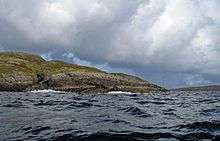Fuiay
Fuiay (Scottish Gaelic: Fùidheigh) is an island in Scotland. It is one of ten islands in the Sound of Barra, a Site of Community Importance for conservation in the Outer Hebrides. Its area is 84 ha and the unnamed highest eminence reaches 107 m. It is located immediately to the west of Flodday and about 1.5 km southwest of Hellisay. Barra lies across the waters of North Bay.

| Gaelic name | Fùidheigh |
|---|---|
| Meaning of name | "House island" from Norse |
| Location | |
 Fuiay Fuiay shown within the Outer Hebrides | |
| OS grid reference | NF740022 |
| Coordinates | 57.0°N 7.37°W |
| Physical geography | |
| Island group | Outer Hebrides |
| Area | 84 ha (210 acres) |
| Area rank | 159= [1] |
| Highest elevation | 107 m (351 ft) |
| Administration | |
| Sovereign state | United Kingdom |
| Country | Scotland |
| Council area | Comhairle nan Eilean Siar |
| Demographics | |
| Population | 0 |
| References | [2][3][4][5] |
The island had six households located along a "street" at Rubh' an Aiseig (English: "ferry headland") in the north west at some point, probably in the early 19th century. It has been uninhabited since about 1850. There is a tidal inlet here that may have been an effective fish-trap.[4][6]
The name may be from the Norse for "house island"[5] or possibly a mixture of the Gaelic bhuidhe, meaning "yellow" and the Norse øy meaning "island".[4]
Fuiay is one of several uninhabited islands off the northeast coast of Barra and other islands in the vicinity include Orosay, Fuday and Gighay. The sea to the north west is peppered with small islets and skerries but there is an anchorage to the north of Rubh' an Aiseig sheltered by the islets of Sgeirislum to the west and Eilean Sheumais to the east.[4] Garbh Lingeigh is a larger islet further to the north in the Sound of Hellisay.
Footnotes
- Area and population ranks: there are c. 300 islands over 20 ha in extent and 93 permanently inhabited islands were listed in the 2011 census.
- 2001 UK Census per List of islands of Scotland
- Ordnance Survey
- Haswell-Smith, Hamish (2004). The Scottish Islands. Edinburgh: Canongate. pp. 224–26. ISBN 978-1-84195-454-7.
- Iain Mac an Tailleir. "Placenames" (PDF). Pàrlamaid na h-Alba. Archived from the original (PDF) on 2008-04-10. Retrieved 2007-07-23.
- "Overview of Fuiay". Gazetteer for Scotland. Retrieved 2008-01-04.
| Wikimedia Commons has media related to Fuiay. |
